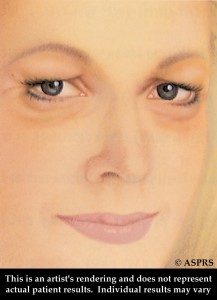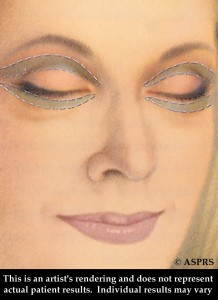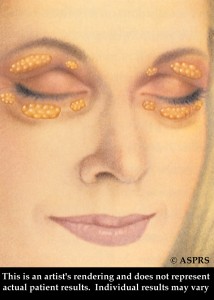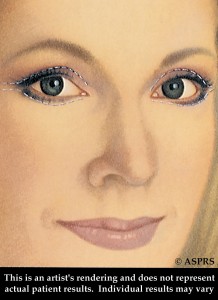INTRODUCTION
Correction of the eyelid is one of the most delicate in aesthetic surgery. It may be performed alone using local anaesthesia or in combination with other surgeries of the face such as during a facelift.
AM I A CANDIDATE FOR THIS SURGERY?
Once the skin of the upper eyelids becomes droopy and sad-looking or bags and wrinkles appear on the lower eyelid, a blepharoplasty may be the right option for you. For the upper eyelids, your surgeon will try to determine whether a blepharoplasty alone is indicated or whether a lifting of the brows is needed. This surgery can be performed equally on men and women since both sexes are affected with this problem with increasing age, giving a tired look. The surgery causes very little pain and can be performed on patients over a wide range of ages.
PROCEDURE
Upper Blepharoplasty
A crescent-shaped excision of skin is made going from the inner corner of the eye to the area of the ‘crow’s feet’. A thin strip of muscle is also removed in order to recreate a natural-looking eyelid crease. If there is excessive fat protrusion, some of the fat is removed. Careful attention is paid to avoid excess resection in order to allow for natural eyelid opening and closing.
Lower Blepharoplasty
An incision is made just below the eyelashes of the lower eyelid. In most cases, an excess of protruding fat from the orbit causes bags of the lower eyelid. Under normal circumstances, the eye uses this fat in order to properly move within its socket. Either a family trait or due to wear and tear, the thin tissues that keep the fat within the eye socket weaken allowing the fat to protrude slightly. The excess fat is carefully evaluated and removed. The muscle is also assessed and any muscle tightening is performed. Finally, careful skin excision is performed being careful not to remove too much.
Surgical correction may be desired in both younger and older adults. It is also possible to perform the fat resection without skin resection or visa versa.
PREPARATION BEFORE SURGERY
Aspirin and all anti-inflammatory medication should not be taken for three weeks before surgery until two weeks after surgery. Anti-inflammatory medication and Aspirin causes thinning of the blood and may lead to excess bleeding during and after surgery. Tylenol (Acetaminophen), however, does not cause this problem and may be taken.
Alcohol in any form is not to be consumed for two weeks before surgery until two weeks after surgery. Alcohol has properties that dilate blood vessels and thin the blood and can contribute to excessive bleeding during and after surgery. Even a small amount can cause problems.
Should you have regular medications to take, ask your surgeon if you should take them before surgery or not. Certain medications can cause problems and only your surgeon can determine this.
AFTER SURGERY
In order to reduce the swelling, you may place cold compresses over the eyes for the few days after surgery. This may be done by using a facecloth dipped in ice-cold water and wringing it before applying. They should be left on until the facecloth becomes warm, usually about 10 minutes. This will make you feel better, especially at the end of the day when swelling tends to recur slightly. Do not place ice directly on the skin as this may freeze the skin and cause skin loss. Also, allow the skin to dry properly between applications.
If swelling is not an issue but there remains some residual bruising after 2 weeks, application of warm compresses may help the bruising fade away faster. Warm compresses may restart the swelling, so use them with this is mind.
Avoid any activities that can increase the blood pressure. Increased blood pressure can cause bleeding and swelling in the 2 weeks after surgery. For example, do not do the dishes, lift heavy objects, clean the house or perform any activities where the face has to be looking down for extended periods. Sexual and other emotionally charged activities should also be avoided for the same reason. Pretend that you are a monk!
Contrary to popular belief, sleeping on three pillows is not necessary. This is true for any surgery.
Do not touch the tapes or sutures. Your surgeon will remove these about one week after surgery
Do not use eyeliner or makeup over the operative area until fully healed, generally around 2 to 3 weeks following surgery. Makeup can be ‘picked up’ by healing incisions and cause ‘tattooing’ of the incision line. Light coloured, water-based make-up is recommended to avoid this problem.
POSSIBLE COMPLICATIONS
Possible ComplicationsCONCLUSION
Blepharoplasty is not a painful procedure that can be easily performed under local anaesthesia. It generally requires about 10 days off from work, but may vary depending on your type of work. It is pleasantly and surprisingly easy for the patient to undergo and gives great results almost immediately by removing the tired look due to bags and excess skin. It can be performed in both men and women over a wide range of ages and is associated with a high degree of satisfaction.




